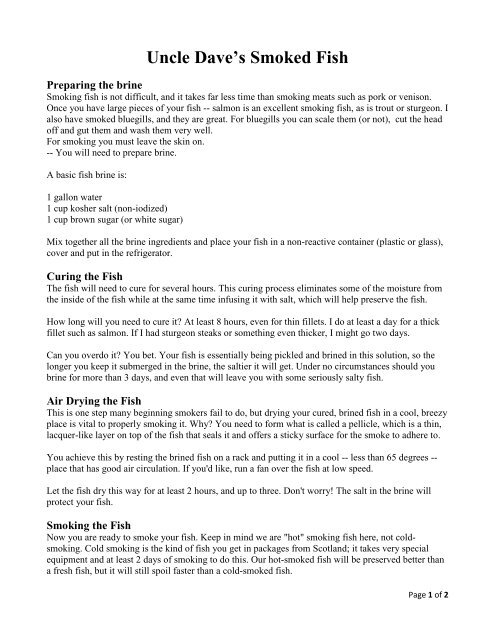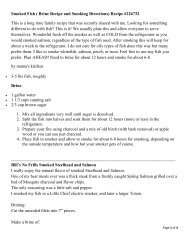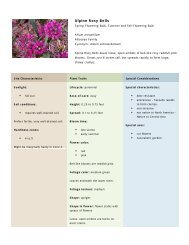Uncle Dave's Smoked Fish.pdf
Uncle Dave's Smoked Fish.pdf
Uncle Dave's Smoked Fish.pdf
Create successful ePaper yourself
Turn your PDF publications into a flip-book with our unique Google optimized e-Paper software.
<strong>Uncle</strong> Dave’s <strong>Smoked</strong> <strong>Fish</strong>Preparing the brineSmoking fish is not difficult, and it takes far less time than smoking meats such as pork or venison.Once you have large pieces of your fish -- salmon is an excellent smoking fish, as is trout or sturgeon. Ialso have smoked bluegills, and they are great. For bluegills you can scale them (or not), cut the headoff and gut them and wash them very well.For smoking you must leave the skin on.-- You will need to prepare brine.A basic fish brine is:1 gallon water1 cup kosher salt (non-iodized)1 cup brown sugar (or white sugar)Mix together all the brine ingredients and place your fish in a non-reactive container (plastic or glass),cover and put in the refrigerator.Curing the <strong>Fish</strong>The fish will need to cure for several hours. This curing process eliminates some of the moisture fromthe inside of the fish while at the same time infusing it with salt, which will help preserve the fish.How long will you need to cure it? At least 8 hours, even for thin fillets. I do at least a day for a thickfillet such as salmon. If I had sturgeon steaks or something even thicker, I might go two days.Can you overdo it? You bet. Your fish is essentially being pickled and brined in this solution, so thelonger you keep it submerged in the brine, the saltier it will get. Under no circumstances should youbrine for more than 3 days, and even that will leave you with some seriously salty fish.Air Drying the <strong>Fish</strong>This is one step many beginning smokers fail to do, but drying your cured, brined fish in a cool, bree z yplace is vital to properly smoking it. Why? You need to form what is called a pellicle, which is a thin,lacquer-like layer on top of the fish that seals it and offers a sticky surface for the smoke to adhere to.You achieve this by resting the brined fish on a rack and putting it in a cool -- less than 65 degrees --place that has good air circulation. If you'd like, run a fan over the fish at low speed.Let the fish dry this way for at least 2 hours, and up to three. Don't worry! The salt in the brine willprotect your fish.Smoking the <strong>Fish</strong>Now you are ready to smoke your fish. Keep in mind we are "hot" smoking fish here, not coldsmoking.Cold smoking is the kind of fish you get in packages from Scotland; it takes very specialequipment and at least 2 days of smoking to do this. Our hot-smoked fish will be preserved better thana fresh fish, but it will still spoil faster than a cold-smoked fish.Page 1 of 2
That said, you still do not want high temperatures. Spray the smoker racks with a vegetable spray toprevent sticking. Place the fish skin side down on the racks. I smoke my fish at around 140 degrees atthe most, although the smoker rarely spends more than 30 minutes at that temperature -- it risesthroughout the smoking process.What wood is the right wood? This is a very contentious subject. Everyone has a favorite. I happen tolike apple wood. Almost anything goes, except for treated wood and pine; pine contains resins that willmake your fish taste bitter. Here are a few common woods for fish:AlderHickoryAppleOakAny other fruit or nut woodHow long? Again, depends on temperature and the bulk of your fish. About 1 to 2 hours for thin fillets,as much as 4 to 5 hours for big slabs of sturgeon or tuna belly.You will get a sense of when it's done once you do this a few times. Until that happens, however, lookfor an internal temperature of 140 degrees -- or when the meat flakes easily.Once the fish is smoked, you can keep it wrapped up in the fridge for 10 days, or freeze it for up to 6months. Vacuum seal the fish if you have one.Page 2 of 2












